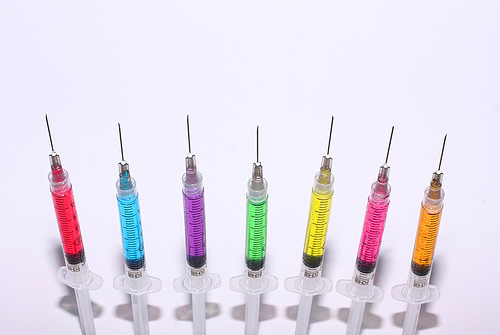Additives to “Dye” For
by Samantha Wilkinson, MS, RDN, LD, Dolce Dietitian
Ever wonder why grape jelly has such a deep purple color, even though grapes are virtually colorless on the inside with a reddish-purple skin? Or how green grapes magically make purple jam? Well the answer is simple, yet dangerous. The FDA currently approves of 9 artificial food colors, three of which are banned from human consumption in the European Union. A simple internet search will turn up countless scientific studies indicating a link between food dyes and various illnesses. If other countries are regulating the consumption of these dyes, then why not the United States?
Did you know that during the pickling process, cucumbers lose all of their natural green coloring and become gray? With the help of food coloring, pickles are packaged in their vibrant green attire since color is positively related to sales, but unfortunately health is not.
Consumers also tend to associate certain flavors with certain colors. Let’s go back to our jelly example. There is a positive correlation between the color purple and grape flavoring. Since we were kids, grape medicine has been purple along with grape jelly, grape juice, grape soda and grape hard candies. Our brains associate purple with grape. So manufacturers make sure to continue that association by artificially dying their products so that their consumers will recognize that associated taste.
In a taste-test study, participants were given an orange Cheeto puff and a white Cheeto puff. Both puffs were manufactured exactly the same way, the ONLY difference was the coloring. Participants stated that the orange Cheetos tasted “cheesier” than the white Cheetos. We associate cheese with the color orange, so despite the Cheetos tasting the exact same, the coloring made all the difference. This is how manufacturers market and sell their products, and this is how they get away with the use of dyes.
Therefore it is extremely important to read the INGREDIENT list on food labels and avoid consuming food dyes whenever possible. As an additional precaution, if an ingredient list has more than 5-6 ingredients (half of which you can’t pronounce) try to find an alternative food.
Beware of these dyes in your foods and think twice before consuming:
Blue No. 1: frosting, ice cream, blue-raspberry flavoring
Blue No. 2: candy, cereal, ice cream
Citrus Red No. 2: coloring skins of oranges (Not approved for use in EU)
Green No. 3: canned peas, mint jelly, sauces (Not approved for use in EU)
Orange B: frankfurter and sausage casings (Not approved for use in EU)
Red No. 3: popsicles, cake-decorating gels, candy, chewing gum
Red No. 40: soft drinks, sport drinks, cocktail mixers, fruit snacks, yogurt, salad dressings
Yellow No. 5: ice cream, popsicles, hard candy, Jell-O, cake mixes, mustard, cereal, jam
Yellow No. 6: orange soda, jam, lemon curd, ice cream, chips, noodles
Let’s strive for whole, Earth-grown foods with natural coloring that hasn’t been lost in processing and added back in, such as, fresh fruits and vegetables. Color is beautiful, but not all color is natural. Be color smart.






